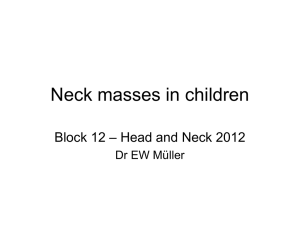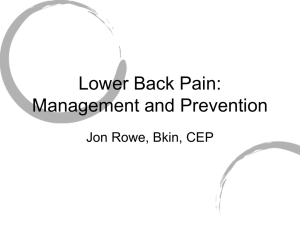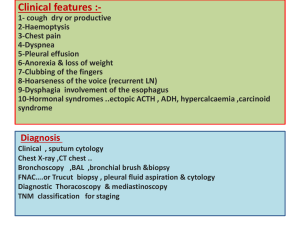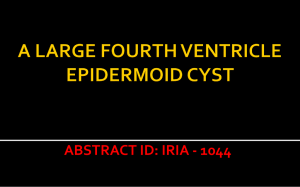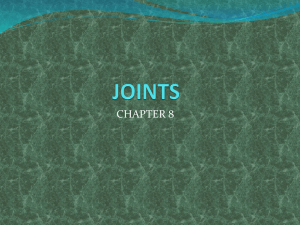facet cyst treatment and literature
advertisement
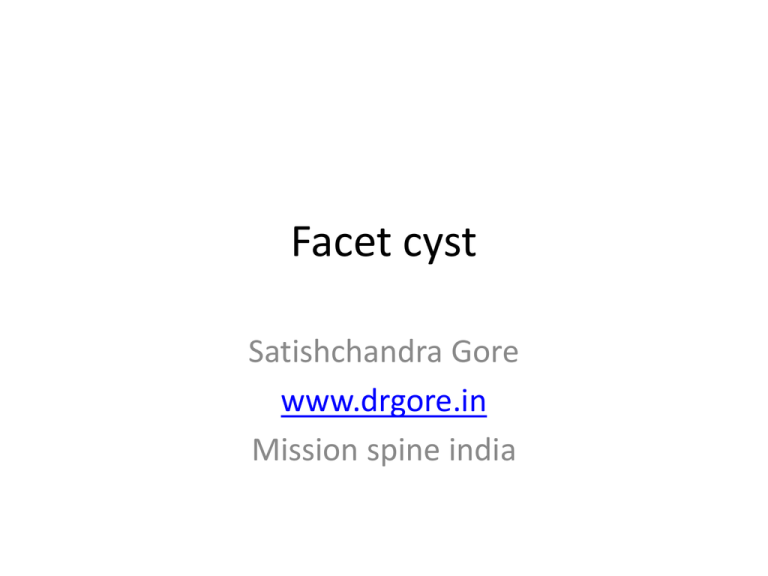
Facet cyst Satishchandra Gore www.drgore.in Mission spine india Facet cyst • facet cysts first reported in 1974 by kao. • terminology has changed but now standardized. • Cysts have been reported mainly as case studies with varying clinical presentations. • anterior intra spinal cysts and which are symptomatic are rare. • With MRI detection is on rise. • May indicate instability. Pathogenesis • Definition: Cyst located beside the facet joint and exhibiting a communication with the joint, as demonstrated on arthrography and subsequent computed tomography (CT) of the joint space. • Result of degeneration of the related facet joint. • Walls consisted of elastic and collagen fibers undergoing fibrinoid degeneration, with or without synovial lining. • should be called "cystic formations of mobile spine" (CYFMOS) • Christophis, P., S. Asamoto, et al. (2007). ""Juxtafacet cysts", a misleading name for cystic formations of mobile spine (CYFMOS)." Eur Spine J 16(9): 1499-1505. Literature review Doyle, A. J. and M. Merrilees (2004). "Synovial cysts of the lumbar facet joints in a symptomatic population: prevalence on magnetic resonance imaging." Spine (Phila Pa 1976) 29(8): 874-878. • synovial cysts are rare. • MRI prevalence on mri in symptomatic patients • anterior cysts (prevalence = 2.3%) posterior (prevalence = 7.3%). • Statistically significant associations with increased frequency and severity of facet joint osteoarthritis and with spondylolisthesis compared to patients without cysts. • Posterior cysts are more common than anterior cysts. Both are related to facet joint osteoarthritis but not to disc disease. Case one : foot drop Lt L45 Case Two • M 65 Dr. Severe sciatica left was relieved with L45 endoscopic nucleotomy • Recurrence showed inc size of synovial cyst • Managed with injection • No neurodeficit so managed non operatively • X rays don’t indicate instability • Patient happy with result of injections images Disc L45 Op now cyst L5S1 Steroid injection Facet arthrography Treatment may not be needed • Spontaneous resolution known • extensive conservative treatment should always be considered as the first therapeutic option, provided that there are no severe neurological deficits. • This may be added by symptomatic treatment. • Symptoms are generally radicular, claudication, backache. Injection or surgery • Shah, R. V. and G. E. Lutz (2003). "Lumbar intraspinal synovial cysts: conservative management and review of the world's literature." Spine J 3(6): 479-488. – nonsurgical management in patients with LISC-induced radicular pain does not appear to be as successful as surgery. • Chang, A. (2009). "Percutaneous CT-Guided Treatment of Lumbar Facet Joint Synovial Cysts." HSS J 5(2): 165-168. • Then surgery – Kahilogullari, G., H. Tuna, et al. (2008). "Management of spinal synovial cysts." Turk Neurosurg 18(2): 211-214. • Surgery effective • Ishii, K., M. Matsumoto, et al. (2005). "Endoscopic resection of cystic lesions in the lumbar spinal canal: a report of two cases." Minim Invasive Neurosurg 48(4): 240-243. effective alternative to conventional open surgery for cystic lesions in the lumbar spine is inter laminar endoscopy. Surgical excision • Khan, A. M., K. Synnot, et al. (2005). "Lumbar synovial cysts of the spine: an evaluation of surgical outcome." J Spinal Disord Tech 18(2): 127-131. – Common at the L4-L5 level, the site of maximum instability. – MRI is the tool of choice for diagnosis. – underlying spinal instability has a strong association for formation of spinal cysts and worsening symptoms. – Synovial cysts resistant to conservative therapy should be treated surgically. – Resection and decompression with fusion remain an appropriate option. • Pirotte, B., N. Gabrovsky, et al. (2003). "Synovial cysts of the lumbar spine: surgery-related results and outcome." J Neurosurg 99(1 Suppl): 14-19. Surgery and excision • Dagain, A., R. Dulou, et al. (2008). "[Surgical management of synovial cyst of the lumbar spine: retrospective study of 52 patients]." Rev Chir Orthop Reparatrice Appar Mot 94(3): 289-296. – Role of fusion is questionable • Deinsberger, R., E. Kinn, et al. (2006). "Microsurgical treatment of juxta facet cysts of the lumbar spine." J Spinal Disord Tech 19(3): 155-160. – can be treated effectively with a minimally invasive microsurgical approach. – when the cysts are associated with spondylolisthesis, minimizing the risk of instability and the need for fusion. – In a selected group of patients with persistent low back pain, fusion may become necessary to improve symptoms. Xu, R., M. J. McGirt, et al. (2010). "Factors associated with recurrent back pain and cyst recurrence after surgical resection of one hundred ninety-five spinal synovial cysts: analysis of one hundred sixty-seven consecutive cases." Spine (Phila Pa 1976) 35(10): 1044-1053. • Hemilaminectomy or laminectomy for symptomatic intraspinal synovial cysts. • immediate improvement in back and leg pain. • However, within 2 years have an increased incidence of back pain and cyst recurrence. • Decompression with instrumented fusion appears to be associated with the lowest incidences of cyst recurrence or back pain. • fusion may be thought about as movement needs to be eliminated. New ideas • Allen, T. L., Y. Tatli, et al. (2009). "Fluoroscopic percutaneous lumbar zygapophyseal joint cyst rupture: a clinical outcome study." Spine J 9(5): 387-395. – Fluoroscopic percutaneous Z-joint cyst rupture appears to be a safe and effective minimally invasive treatment option. This procedure should be considered before surgical intervention. • Martha, J. F., B. Swaim, et al. (2009). "Outcome of percutaneous rupture of lumbar synovial cysts: a case series of 101 patients." Spine J 9(11): 899-904. – steroid injection with attempted cyst rupture is correlated with avoiding subsequent surgery in half of treated patients. Successful cyst rupture does not appear to have added benefit, and it was associated with worse disability 3 years postinjection. Long-term outcomes are similar, regardless of subsequent surgery. Rare presentations • Gadgil, A. A., S. M. Eisenstein, et al. (2002). "Bilateral symptomatic synovial cysts of the lumbar spine caused by calcium pyrophosphate deposition disease: a case report." Spine (Phila Pa 1976) 27(19): E428-431. – Suspect in pts of gout • Manabe, M., M. Doita, et al. (2006). "Far lateral extraforaminal facet cyst causing L5 radiculopathy." J Spinal Disord Tech 19(6): 447-450. Cyst and bleeds • Hemorrhagic cyst is rare – Ramieri, A., M. Domenicucci, et al. (2006). "Lumbar hemorrhagic synovial cysts: diagnosis, pathogenesis, and treatment. Report of 3 cases." Surg Neurol 65(4): 385-390, discussion 390. • Bleeding can occur from adjacent tissue – Miyatake, N., T. Aizawa, et al. (2009). "Facet cyst haematoma in the lumbar spine: a report of four cases." J Orthop Surg (Hong Kong) 17(1): 80-84. • Cyst can give epidural hematoma – Wait, S. D., F. D. Jones, et al. (2005). "Symptomatic epidural hematoma caused by lumbar synovial cyst rupture: report of two cases and review of the literature." Neurosurgery 56(5): E1157; discussion E1157.

